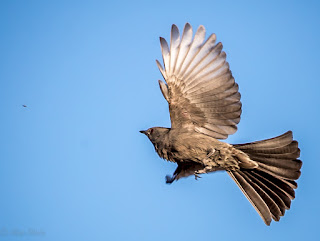A male Great Horned Owl glides into the Big Wash of Tucson, Arizona.
The Big Wash is a dry river bed. It gets occasional water as spring snow melts from the Santa Catalina Mountains or from July's monsoon rains. A pair of Great Horned Owls call these cliff sides home.
It's their territory with few disputes.
They are big beautiful birds in a beautiful setting.
I suspect he's the top arial predator in this part of the Sonoran Desert.
If up all night hunting for rodents, you must sleep during the day.
As I walked through the wash he opened his eyes, but didn't move a feather. I suspect he was no more interested in me than the dozens of coyotes, javelinas and domestic dogs who's tracks I followed.
(Click any picture to enlarge)
But life has interruptions.
A pair of Northern Rough-winged Swallows also claimed this stretch of the Big Wash as THEIR home.
They displayed displeasure by diving on him, only to perch in front of him afterwards, albeit at a safe distance.
The owl took little note of the swallow's property rights or as being anything worth eating.
The female Great Horned Owl has been holed-up for weeks now, thirty feet high in a shallow recess.
I assume she's sitting on eggs.
The male stands guard during the day, ready to do battle with any real threats, three hundred feet south of the nest.
He could take advantage of a mouse or ground squirrel as a daytime snack for his mate, but daytime is a time for rest for these beautiful birds.
Allan
Credits: Cornell Lab of Ornithology, All About Birds
Sunday, March 31, 2019
Friday, March 15, 2019
Common Raven (Elegant Trogon)
I've been stood-up three times this winter by an Elegant Trogon that claims Madera Canyon, Santa Rita Mountains as home. I don't like it and this is getting maddening.
Still, there is little I can do about it except take what nature gives me in observable birds.
Luckily, this day three Common Ravens filled in for the Elegant Trogon and the ravens DIDN'T disappoint.
These gleaming yet shaggy black-throated beauties landed above us, near the spot where the Elegant Trogon normally holds court for uncounted bird photographers.
The three ravens entertained our flock of trogon groupies with proud posing and royal posturing.
They croaked loudly in their unique language, then departed as abruptly as they'd arrived.
Elegant in so many ways, the Common Raven is not flashy... more so stately, refined and polished when seen in proper lighting.
Ravens can be a suitable stand-in for the trogon paparazzi.
Allan
(Click any picture to enlarge)
Saturday, March 9, 2019
Phainopepla (hawking insects)
In the United States, the Phainopepla is a southwestern bird. In Tucson, Arizona they're here year-round.
With a gleaming black body, erect crest and dramatic red eyes, they make you take notice whenever you see one.
The white wing markings are visible only in flight, so watch for that when they fly away.
This being spring, the Phainopepla are in a nest building frame of mind. Presenting material to the female in the tree above was this male's aim.
Not bad, huh?
Fine! Okay! I get it!
This piece is rejected.
Meanwhile, the female Phainopepla in the tree concentrates on food.
The early morning sun had warmed her pale tan body and, most importantly, the sun has the flying insects up and out of the grass.
This tree borders an abandoned golf course fairway. I assume the insects have returned in numbers because the insecticide applications have stopped.
She targets an insect (upper left corner) with an abrupt course correction. Insects are high in protein and are an important food resource for this spring's eventual baby Phainopepla.
(Click any picture to enlarge)
She swings right, then left, as the tiny flying insect (center left) tries to avoid being a snack.
This is a David and Goliath match-up.
Still the insect has maneuverability on its side, though it lacks speed and endurance.
With a swift 180 degree turn, the Phainopepla grabs the insect out of the air. It looks as if this battle is over and a tiny, tiny prize has been won.
But not so fast!
Something happens between this grab-it-'n-go, as the insect escapes.
I can't truly claim the insect got clean away as this was a dizzying chain of twists and turns. It matters little though.
There will be other insects and other birds. What's important is that this exchange continues to repeat in clean air and open space.
Allan
Credits: Cornell Lab of Ornithology, All About Birds
The Sibley Guide to Birds
Subscribe to:
Posts (Atom)















